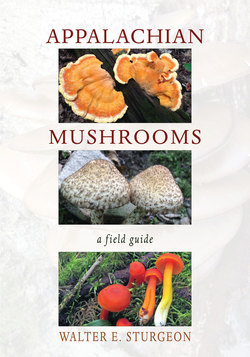Читать книгу Appalachian Mushrooms - Walter E. Sturgeon - Страница 8
ОглавлениеPREFACE
WILD MUSHROOMS OCCUR in all Appalachian habitats, including soil, moss, humus, living trees, dead wood, and manure. Some wild mushrooms have specialized habitats that include insects, other fungi, nutshells, and aphid exudates. Wild mushrooms exhibit an amazing diversity, and there are many more species than can be included in a field guide.
Mushrooms described in this book have been found in the Appalachian region that includes parts of northern Georgia, South Carolina, North Carolina, eastern Tennessee, Kentucky, Virginia, West Virginia, western Maryland, eastern Ohio, Pennsylvania, New York, and the New England states. There is considerable overlap in range, but some species common in New England, for example, are rare or absent in Georgia.
Many species are undescribed and lack a scientific or common name. The number of species in the Appalachian region is unknown. Estimates of close to three thousand species of macro fungi have been proposed. This book has included all of the popular edible species as well as many of the most common poisonous varieties. Some less common interesting species are found in this text as well.
The mushrooms in this book can be identified using features visible to the naked eye. DNA studies have revealed that in some cases mushrooms that are morphologically identical are actually not the same species. Many familiar mushrooms have incorrectly carried names belonging to their European look-alikes. This has resulted in some species temporarily being technically nameless and lumped together as complexes or groups. None of these groups contain look-alike species that differ significantly in edibility. In the future, the species within these complexes will be sorted out. There will be many new species of morels and chanterelles, for example, but all will remain as popular edibles regardless of what they are called.
The search for wild mushrooms is a scavenger hunt that enables the hunter to enjoy some of his or her quarry as food. The natural beauty of wild mushrooms soon becomes apparent. Delving a bit deeper, we see that it is important and fascinating to learn their ecological importance as recyclers, symbionts, insect killers, and a food source for many insects and animals. The finding and subsequent identification of a mushroom may lead to the discovery of much more than food in the amazing fungi kingdom.
